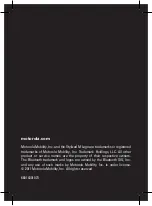
Startup
The Rear Panel
2-2
NEVER
block the ventilation openings on the bottom or rear panels; doing so can cause
overheating and serious damage. To provide adequate ventilation, the rear panel should be at
least four inches from any vertical surface.
There are no user-serviceable parts in the K2vx
.
Under no circumstances should you attempt to remove any panels (except for battery
installation or replacement). If you attempt to open your K2vx, youÕll risk electric shock, and
youÕll void your product warranty.
The Rear Panel
Battery Installation
WeÕve included three AA batteries for your K2vxÕs battery-backed RAM. We didnÕt install the
batteries at the factory because they would drain during shipping. You should install the
batteries before you start up your K2vx.
Locate the battery compartment in the lower right-hand corner of the rear panel (refer the
illustration on the following page). Remove the battery compartment cover by inserting a ßat-
head screwdriver or coin into its slot, then turning it counterclockwise until it pops out. Slide
the three batteries, all positive side out, into the compartment. Install the battery compartment
cover by lining up the tabs, pushing the cap inward, then turning it 90
°
. When you start up
your unit for the Þrst time after installing the batteries, it will take a few minutes to initialize all
of its memory. This will not happen on every power up.
Connecting the Power Cable (Line Cord)
The K2vx runs on 100-, 120-, 220-, or 240-Volt AC power at 50Ñ60 Hz. Your dealer will set the
voltage switch to match the voltage in your area. The voltage level is set with a selector on the
rear panel of the keyboard models of the K2vx. On the K2vxR, however, the voltage setting can
only be changed by an authorized Kurzweil service center.
As you face the rear panel of the K2vx, the power connector is toward the righthand side. When
youÕve connected the cable at the K2vx end, plug it into a grounded outlet. If your power
source does not have the standard three-hole outlet, you should take the time to install a proper
grounding system. This will assure you of avoiding problems with audio hum, and will reduce
the risk of a shock hazard.
Connecting the Audio Cables
.
Did you turn down the level on your PA yet?!
After youÕve turned down the level on your sound system, you can rig the K2vxÕs audio
connections using a pair of mono audio cables. YouÕll Þnd ten 1/4-inch jacks near the top of the
rear panel. For now, connect one end of each audio cable to your mixing board or PA system
inputs, and connect the other end to the jacks marked MIX L and R on the rear panel of the K2vx.
If you have only one input available, use the K2vxÕs MIX L output to get the full signal in mono.
ItÕs always a good idea to make the cable connection to the K2vx (or any instrument) after
youÕve made your other audio connections, since this will reduce the chance of creating static
electricity that can cause an audible "pop" (and, in extreme cases, cause equipment damage).
Turn to Chapter 18 for more detailed information about the K2vxÕs audio conÞguration.
Connecting MIDI
The simplest MIDI conÞguration uses a single MIDI cable, from the MIDI Out port of your
MIDI controller to the MIDI In port of the K2vx. There are all sorts of possible conÞgurations,
including additional synths, personal computers, MIDI effects processors, and MIDI patch
bays. Depending on your system, you may want to use the K2vxÕs MIDI Thru port to pass
MIDI information from your MIDI controller to the K2vx and on to the next device in your
system. You can also connect MIDI devices to the K2vxÕs MIDI Out port, which can send
channelized MIDI information from your MIDI controller. See the discussion of the Local
Keyboard Channel parameter in Chapter 10.
Summary of Contents for K2500RS
Page 12: ...Table of Contents TOC 12...
Page 16: ...Introduction How to use this manual 1 4...
Page 32: ...User Interface Basics The Panel Play Feature K2vxR 3 8...
Page 106: ...Effects Mode and the Effects Editor Configurations and Parameters 9 24...
Page 186: ...Song Mode Recording Multi timbral Sequences via MIDI 12 52...
Page 304: ...DSP Functions Hard Sync Functions 14 52...
Page 394: ...Programs Setups and Keymaps K2500 ROM Keymaps 21 12...
Page 402: ...LFOs LFO Shapes 23 4...
Page 406: ...Note Numbers and Intonation Tables List and Description of Intonation Tables 24 4...
Page 434: ...DSP Algorithms 26 14...
Page 450: ...MIDI and SCSI Sample Dumps SMDI Sample Transfers 29 8...
Page 464: ...Glossary 31 6...
Page 490: ...K2vx Program Farm VOX K25 Appendix A 22...
Page 494: ...K2vx Compatibility Converting programs from the K2vx to K2000 Appendix B 4...
















































